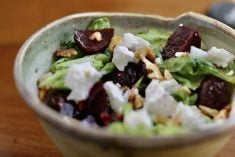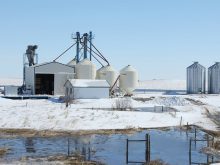For years we have conserved energy by washing in cold water and hanging clothes to partially dry. Hanging clothes to dry in the house also helps increase humidity during the winter. Maybe many of you have also adopted these habits.
Here are some laundry facts:
- A typical Canadian household does 6.3 loads of laundry a week, using 810 litres of water. This converts to more than 327 loads of laundry and 42,000 L of water a year.
- Eighty-five percent of the energy that is needed to operate a washing machine is used to heat the water.
- Converting to cold water washing for one year may save the amount of energy equivalent to
190 L of automobile fuel, which is equivalent to 1,610 km driven in an average car.
Read Also

Communication key to bridging generation gap
Each generation is shaped by the predominant forces at play during their formative years. Acknowledging these influences can improve communication among the generations.
The Canadian Energy Efficiency Alliance has launched a consumer education campaign to inform Canadians how much energy and money they can save if they switch to cold water, especially in the winter when energy demand is high.
The typical Canadian family that washes in warm and rinses in cold could save up to 620 kWH a year, which translates to a savings of up to $52 dollars a year. The savings increase to $217 per year if families are using only hot water and switch to cold. As well as saving energy and money, Canadians will also be saving the environment by creating fewer greenhouse gas emissions.
Detergents designed especially for cold water washing provide excellent cleaning results.
Energy saving laundry room tips:
- Wash with a full load whenever possible.
- Set the dryer timer for a shorter cycle; hang partially dry clothing and towels to dry.
- The electric iron uses a lot of energy. Taking clothes promptly from the dryer and folding or hanging them eliminates the need for ironing.
Source: Canadian Energy Efficiency Alliance
Wheat-free recipes and menus
Carol Fenster was told to avoid wheat 15 years ago and ever since she has been developing and refining gluten-free recipes. Her latest book, Wheat-Free Recipes and Menu: Delicious Healthful Eating for People with Food Sensitivities, has chapters on breads and pasta, grains and beans, soups, sauces, vegetables, main courses and desserts. It has a chapter focused on breakfast dishes such as waffles, pancakes and muffins because breakfast is typically a wheat-based meal. Fenster has basic recipes that include pizza, french bread, sandwiches and pasta, as well as contemporary choices such as focaccia, bagels and breadsticks. Each recipe’s nutrient content based on U.S. Department of Agriculture guidelines is provided.
Best ever meat loaf
This makes a flavourful, moist loaf. The sauce on top and inside the meat loaf adds extra moisture. You can make your own bread crumbs from leftover gluten-free bread. Makes four servings.
1 can (8 oz.) tomato sauce 250 g
1Ú4 cup packed light brown sugar 60 mL
1Ú2 teaspoon dry mustard 2 mL
1Ú2 teaspoon chili powder 2 mL
1Ú4 teaspoon ground cloves 1 mL
1 garlic clove, minced
1 teaspoon Lea & Perrins 5 mL
Worcestershire sauce
3Ú4 pound lean ground beef 375 g
1Ú4 pound lean ground turkey 125 g
1 large egg, lightly beaten
1 cup dried gluten-free bread 250 mL
crumbs
1Ú2 teaspoon salt 2 mL
1Ú4 teaspoon ground black pepper 1 mL
1 tablespoon instant chopped onion 15 mL
Preheat the oven to 350 F (180 C). In a small bowl, combine the tomato sauce, sugar, mustard, chili powder, cloves, garlic and Worcestershire sauce. Mix well.
Add half of the tomato mixture to a large bowl. Add all the remaining ingredients. Mix well with your hands. Shape the mixture into a loaf, either rounded or rectangular, and place in a baking pan. If desired, place loaf on a metal rack, such as a round, perforated rack, which allows the fat to drip through to the bottom of the pan and keeps the fat away from the loaf during baking. Make an indentation in the centre of the loaf and pour in the remaining tomato mixture. Bake for 45 minutes, or until the loaf is browned.
Note: Some pre-ground dry mustard contains wheat; grind your own mustard seeds or look for Durkee of Spice Islands dry mustard or another gluten-free kind.
Source: www.savorypalate.com and Wheat-Free Recipes and Menus: Delicious Healthful Eating for People with Food Sensitivities by Carol Fenster.
Looking for bun recipe
Dear TEAM: A few years ago I got a recipe out of the Western Producer, but somehow I lost it, and can’t remember all that was in it. I think it was called sticky buns. It called for an angel food pan, then you put nuts, raisins, brown sugar and butter, honey, syrup or water in the bottom, covered with 10 or 15 frozen balls of bun dough. Then we covered it with damp cloth overnight and put in the oven for 30 minutes or so in the morning. When turned out, it gave you golden brown sticky buns hot for breakfast. Could you reprint this recipe for me? Ñ Mrs. W.N., Estevan, Sask.
Dear Mrs. W.N.: Here is a recipe that we have made that sounds like the one you are describing:
Sticky buns
20 frozen dough rolls
1 cup brown sugar 250 mL
1Ú4 of a 106 g package vanilla 26 g
instant pudding
1Ð2 tablespoons cinnamon 15-30 mL
1Ú4 cup melted butter 60 mL
3Ú4 cup raisins or nuts (optional) 175 mL
1Ú4 cup corn syrup 60 mL
Into a greased bundt pan, pour corn syrup and water, add the frozen rolls, sprinkle with brown sugar, pudding powder, cinnamon and raisins over top of the frozen rolls. Pour melted butter over all of this. Cover with plastic wrap or a damp cloth and leave at room temperature overnight. In the morning, bake 25 minutes at 350 F (180 C) oven. Let set five minutes and enjoy.
Oat bran muffins
Dear TEAM: Would you have a recipe for light oat bran muffins? We get them in the coffee shop at Zellers. They are so big and light. I have tried to make them but while mine rise well, they are not as light as the cafeteria’s muffins. I have made them with milk and also with lactobacillus yogurt culture and still the same results. Is there another rising powder on the market other than baking soda? I’ve seen it listed on baked goods sold in stores. Hope you can help me. Ñ E.R. Virden, Man.
Dear E.R.: There are many leavening agents available to the baker that create gases that cause the dough to rise: active dry yeast; sourdough starter; baking soda (sodium bicarbonate) and baking powder (baking soda, calcium phosphate, and sodium aluminum sulfate). Baking soda needs an acid such as sour milk or molasses to work properly. Baking powder is baking soda combined with an acid.
The following recipe makes a light muffin with just the banana. I also made the recipe with the addition of apple and apricots.
Oat bran muffins
11Ú4 cup flour 310 mL
1 cup oat bran 250 mL
1Ú2 cup sugar 125 mL
1 tablespoon baking powder 15 mL
1Ú2 teaspoon salt 2 mL
4 tablespoons butter, melted 60 mL
3Ú4 cup skim milk 175 mL
1 egg
1 teaspoon vanilla 5 mL
1Ú2 cup mashed bananas 125 mL
1 medium apple, optional
1Ú4 cup dried apricots or fruit and 60 mL
nut mixture, optional
Preheat oven to 400 F (200 C). Line muffin tin with paper muffin cups. Combine dry ingredients and set aside. In a large bowl, mix together butter, milk, egg, vanilla and bananas. Add in dry ingredients and stir until just combined. Divide batter among prepared muffin cups and bake for about 20 minutes or until light golden brown on top. Transfer to rack to cool. Serve warm.
Barbara Sanderson is a home economist from Rosetown, Sask., and one of four columnists comprising Team Resources. Send correspondence in care of this newspaper, Box 2500, Saskatoon, Sask., S7K 2C4 or contact them at team@producer.com.














